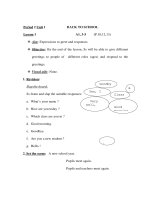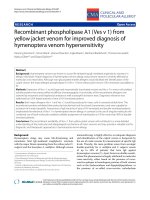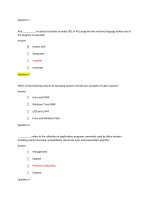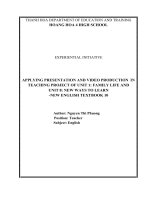O3 a1 learning unit 1 final presentation
Bạn đang xem bản rút gọn của tài liệu. Xem và tải ngay bản đầy đủ của tài liệu tại đây (2.73 MB, 76 trang )
DIGITAL AND
ENVIRONMENTAL
SKILLS FOR FACILITIES
MANAGEMENT
O3 - A1 Learning Unit 1
Sustainability and
Environmental Issues
and their Impact on FM
DATE: 01 DECEMBER 2017 - Prepared
Project Start Date - October 1st,
2016
Project End Date - March 31,
2019
Duration in months - 30 months
Project code 2016 -1-UK01KA202-024420
Title
Learning Unit 1
Description
Description
Overall Learning
Outcome
Sustainability and Environmental Issues and their
Impact on FM
This learning unit introduces the learner to sustainability
and environmental management and provides basic facts
and principles that improve resource efficiency in or for
buildings, covering different types of FM operations. It
introduces to the key EU and national legislation on
environmental issues.
Learners should understand key concepts of the
environmental and sustainability principles in order to
develop a coherent and efficient saving energies policy.
Also, learners should comprehend what EU and national
environmental laws address and know which the main
legislation covering the various topics related to energy
saving practices for the building industries.
EQF level
Duration
ECVET credits
Prerequisites
Assessment
4-5
20 hrs NLT
1
General
1 assignment: case-study (5 open-ended questions
and/or multiple choice test).
Learning Outcome 1 Describe the fundamental principles of environmental
management and sustainability in relation to FM.
Learning Outcome 2 State at least 3 energy saving measures for buildings.
Learning Outcome 3 Explain how to manage and implement energy efficiency
within the buildings in the short- and long-term.
Learning Outcome 4 State the main national and EU environmental policy
principles (laws) on energy saving practices for the
building industry.
Learning Outcome 5 Advise customers on how to improve resource efficiency
in or for buildings.
Sustainability
Sustainability has increasingly become a rising concern for all areas of life
Increasing population size and living standards are resulting in degradation of earth’s resources
Developing need to “meets the needs of the present without compromising the ability of
future generations to meet their own needs” Former Prime Minister of Norway, Gro Harlem Brundtland.
Societal requirement to take Earth’s carrying capacity into account across all sections of life
Sustainable practices;
recognise the needs of everyone
protect the environment
carefully use natural resources
maintain high and stable levels of economic growth and employment
The Business Case for Sustainability in the UK Property Sector
The current dilemma of the human-being
The human-being as a part of the
environment
The human-being as influence of the
environment
Sustainability
Environmental, Social and Economic responsibility
Sustainability is an overarching ethos covering three areas which must interlink
Sustainable development
Wide range of sub topics
Impacts on all aspects of life
Much wider than environmental and energy issues
UN Sustainable Development Agenda lists 17 Goals
Economics, food, health, education, energy,
infrastructure, equality, construction,
climate, land & water
Economic
Environmental
Social
The target of the Facility Management
Social
costs
Environmental
costs
Optimal “Triple Bottom Line”
new slide
Economical
costs
Sustainability in Facilities Management
Energy
Waste
Water
Productivity
Maintenance
Lifecycle costs
Total cost of ownership
Organisation behavioural change
Compliance with regulation
Ergonomics & occupational quality conditions (air quality and velocity, temperature, humidity, illumination,
health & safety, etc.)
Sustainability in Facilities Management
A wider view of sustainability incorporates;
Social value
Agile working
Wellbeing
Social value
Sustainability has grown in overall importance within the FM sector;
35% say it is extremely important and 37% say it is very important.
The main reasons for sustainability’s importance are;
Resource and cost management
Customer expectations
Legislative compliance
Health/safety
Ethics and community investment
‘Green’ image
British Institute of Facilities Management;
Sustainability Survey 2017
Environmental Management
The active management of society’s impact on the environment.
Balance the use of natural resources and unsustainable materials
Pollution control
Waste management
Natural resource consumption
Public health
Recycling
Compliance with environmental regulation
Development and Implementation of Environmental management policies
Environmental Management Policies
Statement of key points the organisation wishes to achieve with actions to be taken on;
Waste
Resources
Recycling
Compliance with legislation
Policy should achieve buy-in across all levels within the organisation
Policy should be communicated;
Internally within the organisation
Externally to customers and suppliers
Environmental Management Policies
Regular monitoring and reporting of outcomes to ensure progress
Promotion of achievements
Consider implementing ISO 14001 (Environmental Management)
Improving resource efficiency
Resource efficiency increasingly important as input costs rise
Valuable method of reducing running costs and overheads
Opportunity to release funds for facility improvements
Environmental and social benefits to be gained by becoming more resource efficient
Enhances the FM Company’s profile and can be used as a powerful tool to attract new business
Resource Efficient Scotland; Resource Efficiency in Schools
Methods to improve resource efficiency
What is the current baseline?
Collect & Analyse Data (benchmarking)
Electricity/oil/gas consumption
Waste production & practices
Water & waste water
Review of any current resource efficiency practice
Discussion with building users
Scale of opportunity for savings is influenced by the initial building fabric and operations being carried out
within it
Improving resource efficiency - strategy
Setting SMART Targets for resource efficiency
• Achieve buy-in from across the organisation
• Ensure targets allow achievement of numerous goals
• Consider achievement of legal requirements
• Set short and Long term targets for achievement
• Include anticipated costs/budget for each action
• Consider the quick wins to give early success
• Promotion of the activities being undertaken
Resource Efficient Scotland; Resource Efficiency in Schools
Reducing Resource Use in Buildings
Consumption of resources and environmental impacts of a building can be reduced by:
Promoting better initial building design
Weighting resource use against the needs and functionality of the building
Considering future need for re-configuration or deconstruction
Ensuring a greater use of energy efficient products
Using recycled materials & reusing existing materials
Promoting more resource efficient construction and renovation
Reducing waste sent to landfill by using the waste hierarchy
Placing a financial value on being resource efficiency.
Involving the competences of the facility manager during the design
to reduce the resource use during the building operation.
Sustainability, Environmental & Resource Efficiency Opportunity
Buildings are responsible for;
40% of energy consumption in EU
36% of CO2 emissions in the EU
Older buildings typically require 5-7 times more energy than new buildings with 35% of the EU's buildings being
over 50 years old.
By improving the energy efficiency of existing buildings, the total EU energy consumption and CO 2 emissions
could be reduced by 5-6%.
/>About 75% of buildings are energy inefficient
Depending on the Member State, only 0.4-1.2% of the stock is renovated each year.
Energy Saving in Facilities Management
Data
Accurate and detailed energy data is an essential requirement and allows for;
Tracking of impact of changes in building management practices
Comparison between similar buildings
Comparison of annual energy consumption
Identification of areas within properties needing special attention
Energy management will assist in reducing the performance gap between building design/targets and the
actual performance achieved on site
Energy saving policy will heavily influence;
Reactive and planned maintenance decisions
Replacement equipment purchase specifications
Steps to improve energy efficiency
1. Energy audit and measure: Collect the data and analyze
2. Fix the basics: Deploy low cost, high yield fixes to blatant energy waste
3. Optimize through automation and regulation: Integrate energy management into everyday processes
through use of modern, high efficiency technologies
4. Monitor, maintain, and improve: ensure savings are embedded and sustained
5. Does the operator have a full understanding of the Building Management System (BMS)?
6. Consider implementing ISO 50001 (Energy Management)
www.schneider-electric.com
Energy efficiency at all costs?
What gives the best value for money
Initial capital expenditure Vs payback period
Complexity of new build or retrofit into existing space
Requirements and cost of maintenance
Accessibility of all installed energy equipment
Is the equipment easy to operate
How will others who are not familiar with the system engage with it?
Eliminate as much as possible the influence of the space users to the energy efficiency and involve as much a
possible state-of-the-art technical solutions in this regard (in general the occupants take care much more about
their daily tasks and obligation than the energy efficiency and savings)
Heating considerations
Is a consistent temperature required
Can heating systems be turned down at night
What are the hours of occupation (if possible look for tenants with similar working time)
Type of activities occurring in the building
Is heat generating equipment being used – can excess heat be re-used?
Requirement for cooling?
Position of sensors within the room?
Use window sensors to turn off the heating/cooling when the windows are open
Appropriate type of heat source - underfloor / radiant / air
Thermal comfort for occupants (dependant on type of work undertaken)
Ceiling heights
Overall building fabric
Servicing of heat generating plant and equipment
Requirement for hot water
Use local technical solutions for special cases (for example cooling for server rooms)









